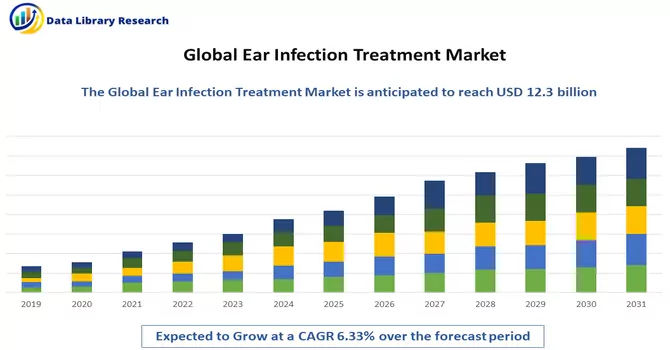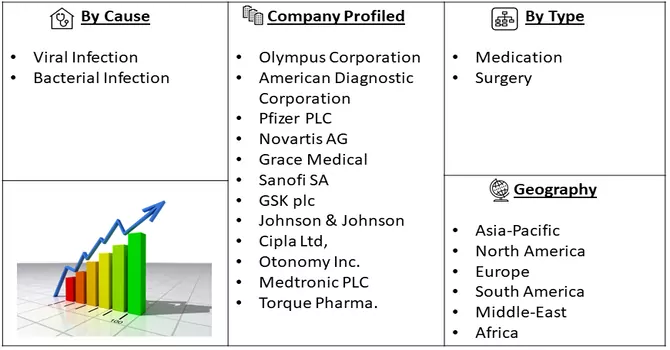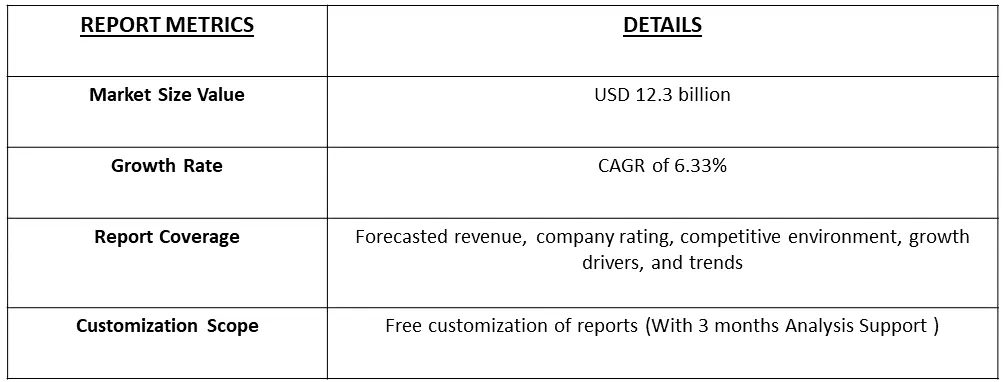The global ear infection treatment market size was valued at USD 12.3 billion in 2023 and is expected to grow at a compound annual growth rate (CAGR) of 6.33% from 2024 to 2031.

Get Complete Analysis Of The Report - Download Free Sample PDF
Ear infection treatment involves various medical interventions tailored to address infections affecting different parts of the ear. Antibiotics are commonly prescribed for bacterial ear infections, with the specific choice depending on factors such as the type and severity of the infection. Pain management, including the use of pain relievers and warm compresses, helps alleviate discomfort associated with ear infections. In cases of otitis externa, antibiotic or antifungal ear drops may be recommended. It is essential to avoid activities that could worsen the infection. Some cases may be observed and monitored for resolution, while severe or recurrent infections may require additional treatments or surgical interventions. Seeking prompt medical attention for accurate diagnosis and appropriate treatment is crucial for individuals experiencing symptoms of an ear infection, such as ear pain or drainage.
The growth of the market is the increasing prevalence of ear infections on a global scale. The surge in ear infections is particularly noteworthy due to the potential consequences such as hearing loss, attributed to inflammation and the accumulation of fluid behind the eardrum. These infections can affect the inner, middle, or outer ear, with causative factors including bacterial or viral infections. The rising incidence of ear infections underscores the pressing need for effective and accessible treatments to address not only the infections themselves but also the associated risks, emphasizing the significance of advancements in ear infection management within the healthcare landscape.
The Ear Infection Market is marked by dynamic trends that shape the industry's trajectory. Technological advancements, particularly in diagnostic tools and imaging techniques, are driving a shift toward more advanced and precise methods of ear infection detection, exemplified by the introduction of artificial intelligence models such as Mass Eyes and Ear's OtoDX. There is a noticeable focus on addressing pediatric ear infections, leading to the development of specialized treatments for different demographics. Product launches and formulation improvements, like Sandoz Inc.'s Ciprofloxacin + Dexamethasone otic suspension, underscore the ongoing efforts to expand treatment options and enhance medication efficacy. Increasing awareness about the consequences of untreated ear infections is fueling educational initiatives and public health campaigns, promoting proactive ear care and timely interventions. The market is also influenced by global variations in ear infection incidence rates and healthcare infrastructure, with emerging markets gaining attention. Moreover, a growing emphasis on preventive measures and hygiene practices reflects a broader trend toward holistic approaches to ear health in diverse environments.
Market Segmentation: The report covers the Global Ear Infection Treatment Market is Segmented by Cause (Viral Infection and Bacterial Infection), Type (Medication and Surgery), and Geography (North America, Europe, Asia-Pacific, Middle East and Africa, and South America). The report offers the value (in USD million) for the above segments.

For Detailed Market Segmentation - Download Free Sample PDF
Market Drivers:
Rising Prevalence of Ear Infections
The escalating prevalence of ear infections globally underscores the critical need for effective ear infection treatment. Ear infections, whether affecting the inner, middle, or outer ear, can lead to complications such as hearing loss due to inflammation and fluid accumulation. This rise in incidence has fueled increased attention and investment in developing advanced treatment modalities. Utilizing a combination of antibiotics for bacterial infections and anti-inflammatory agents, ear infection treatment aims to alleviate symptoms, eliminate causative agents, and prevent complications. Moreover, technological innovations, such as artificial intelligence models like Mass Eyes and Ear's OtoDX, are contributing to more accurate and efficient diagnosis, enhancing the overall efficacy of treatments. The proactive approach to addressing the rising prevalence of ear infections involves not only curative interventions but also preventive measures, emphasizing the importance of good ear hygiene practices and early detection for optimal ear health.
Increase In Research and Development in the Field of Ear Infections
The market for ear infection treatment is experiencing substantial growth, propelled by the increasing healthcare expenditure and heightened investment in research and development within the field. Notably, significant efforts are underway to advance therapeutic approaches, as highlighted by the University of Western Australia's research. In August 2022, the university reported the development of a silk-based solution aimed at curbing the uncontrolled growth of biofilms that surround bacteria in infected ears, hindering treatment effectiveness. This innovative solution signifies a commitment to exploring novel strategies for overcoming challenges in ear infection therapy. Furthermore, the University at Buffalo's research update in August 2022 revealed a potential breakthrough, indicating that earbuds equipped with Bluetooth technology may soon have the capability to detect common ear infections and other ailments. This novel system involves connecting Bluetooth earbuds to a smartphone integrated with a deep learning platform, showcasing the integration of cutting-edge technology in the quest for more efficient and technologically advanced approaches to ear health diagnostics and treatment.
Market Restraints:
High Costs and Complications Related to Surgical Procedures
The ear infection treatment market faces potential challenges due to the high costs and complications associated with surgical procedures. While surgical interventions may be necessary in certain cases, such as chronic or severe ear infections, the financial burden and potential complications can impact the overall market dynamics. Surgical procedures, including tympanoplasty or mastoidectomy, can incur significant healthcare costs, limiting accessibility for certain patient populations. Additionally, the inherent risks and complexities associated with surgical interventions may deter individuals from opting for these procedures, affecting the overall adoption rate. As the market navigates these challenges, there is a growing need for cost-effective and minimally invasive alternatives to surgical treatments, emphasizing the importance of research and development in providing innovative solutions that balance efficacy, affordability, and patient safety in ear infection treatment.
The COVID-19 pandemic exerted widespread influence on the healthcare industry, including the ear infection drugs and surgeries market, with substantial disruptions to global businesses and economic activities. Notably, a PubMed article from February 2021 highlighted a significant decrease in the prescription rate for antibiotics for respiratory and ear infections, plummeting from 21% to 13% during the pandemic. Lockdown measures hindered patients from visiting clinics for routine check-ups, contributing to a noteworthy impact on the ear infection market. Despite these challenges, the market is poised for growth in the forthcoming years. Anticipated drivers include an increase in product launches for ear infection treatment, a rise in ear-related complications, and heightened research and development activities focused on ear-related infections. These factors collectively indicate a potential rebound and expansion in the ear infection market post the pandemic era.
Segmental Analysis:
Viral Infection Segment is Expected to Witness Significant Growth Over the Forecast Period
The management of ear infections involves addressing various infectious agents, and when it comes to viral infections, a nuanced approach is essential. Viral agents, such as those responsible for conditions like viral otitis media, require specific considerations in their treatment. Unlike bacterial infections, viral infections do not respond to antibiotics, the conventional treatment for bacterial ear infections. Instead, antiviral medications may be considered in certain cases, depending on the specific virus causing the infection. However, viral ear infections often resolve on their own, with treatment focusing on symptom relief. Pain relievers, anti-inflammatory medications, and sometimes antiviral drugs may be recommended to alleviate symptoms and support the body's natural healing process. It is crucial for healthcare professionals to accurately diagnose the nature of the infection to tailor the treatment plan accordingly, ensuring effective and targeted care for individuals dealing with viral ear infections.
Antibiotics Segment is Expected to Witness Significant Growth Over the Forecast Period
Antibiotics play a crucial role in the treatment of ear infections, particularly those caused by bacterial agents. Conditions such as acute otitis media (middle ear infection) and bacterial otitis externa (outer ear infection) often necessitate antibiotic therapy. The choice of antibiotics depends on factors such as the type of bacteria involved and the severity of the infection. For acute otitis media, amoxicillin is a commonly prescribed antibiotic for its effectiveness against the predominant bacteria responsible. In cases of penicillin allergy or treatment failure, alternative antibiotics like azithromycin or cephalosporins may be consider. For bacterial otitis externa, topical antibiotics in the form of ear drops are often preferred. Commonly used antibiotics in ear drop formulations include neomycin, polymyxin B, and hydrocortisone. Thus, such factors to note that antibiotics are effective only against bacterial infections, and they do not address viral ear infections. Overprescribing antibiotics can contribute to antibiotic resistance, emphasizing the importance of accurate diagnosis and targeted antibiotic use in ear infection treatment. It is always recommended to follow healthcare professionals' advice and complete the prescribed course of antibiotics to ensure successful treatment and prevent recurrence.
North America Region is Expected to Witness Significant Growth Over the Forecast Period
The ear infection treatment market in North America is poised for growth, driven by several factors contributing to increased incidence rates and advancements in research and development. According to a March 2021 article by the National Institute on Deafness and Other Communication Disorders, a significant prevalence of ear infections is observed in the region, with five out of six children experiencing an ear infection by the age of three. This high incidence rate, particularly in children aged 6 to 24 months, where otitis media is most commonly observed, underscores the substantial market potential. Additionally, ongoing research initiatives, exemplified by a clinical study sponsored by Rochester General Hospital in New York, aim to identify dynamic changes in nasopharyngeal colonization patterns and acute otitis media etiology involving antibiotic-resistant bacteria. The significant economic impact of ear infections, estimated to exceed USD 4 billion in annual costs in 2021, as per the NIH's August 2021 update, further highlights the market's growth potential. With an increasing number of ear infections, rising research and development activities, and a commitment to understanding the complexities of the condition, North America is expected to witness robust growth in the ear infection treatment market throughout the forecast period.

Get Complete Analysis Of The Report - Download Free Sample PDF
Major market players actively pursue strategies such as expanding their production capabilities, engaging in mergers and acquisitions, and conducting research and development initiatives to maintain a competitive edge in the industry. This involves increasing their capacity for manufacturing, acquiring other companies or merging with them to strengthen their market position, and investing in innovative research and development efforts. These strategic moves are crucial for staying ahead of competitors, enhancing market share, and ensuring sustained growth in the dynamic business environment. The commitment to these initiatives underscores the players' proactive approach in adapting to market trends, meeting evolving customer demands, and securing a prominent position in the competitive landscape. Key market players include:
Recent Developments:
1) In August 2022, Mass Eyes and Ear introduced OtoDX, an artificial intelligence (AI) model designed for the detection of pediatric ear infections. Utilizing 22 test pictures, OtoDX boasts an impressive 95% accuracy in identifying ear infections. This innovative AI model offers a promising tool for efficient and accurate diagnosis, particularly in pediatric cases where prompt detection is crucial.
2) Additionally, in August 2020, Sandoz Inc. officially launched Ciprofloxacin 0.3% + Dexamethasone 0.1% otic suspension in the U.S. market. Available in a 7.5mL ear drop solution, this product is specifically formulated for the treatment of bacterial infections in both the middle ear and outer ear canal. The introduction of this otic suspension provides healthcare professionals with a targeted and 3. effective treatment option for individuals dealing with bacterial infections in these critical ear areas.
Q1. What was the Ear Infection Treatment Market size in 2023?
As per Data Library Research the global ear infection treatment market size was valued at USD 12.3 billion in 2023.
Q2. At what CAGR is the Ear Infection Treatment market projected to grow within the forecast period?
Ear Infection Treatment Market is expected to grow at a compound annual growth rate (CAGR) of 6.33% over the forecast period.
Q3. What segments are covered in the Ear Infection Treatment Market Report?
By Cause, By Type and Geography these segments are covered in the Ear Infection Treatment Market Report.
Q4. Which Region is expected to hold the highest Market share?
North America region is expected to hold the highest Market share.
Data Library Research are conducted by industry experts who offer insight on industry structure, market segmentations technology assessment and competitive landscape (CL), and penetration, as well as on emerging trends. Their analysis is based on primary interviews (~ 80%) and secondary research (~ 20%) as well as years of professional expertise in their respective industries. Adding to this, by analysing historical trends and current market positions, our analysts predict where the market will be headed for the next five years. Furthermore, the varying trends of segment & categories geographically presented are also studied and the estimated based on the primary & secondary research.
In this particular report from the supply side Data Library Research has conducted primary surveys (interviews) with the key level executives (VP, CEO’s, Marketing Director, Business Development Manager and SOFT) of the companies that active & prominent as well as the midsized organization
FIGURE 1: DLR RESEARH PROCESS

Extensive primary research was conducted to gain a deeper insight of the market and industry performance. The analysis is based on both primary and secondary research as well as years of professional expertise in the respective industries.
In addition to analysing current and historical trends, our analysts predict where the market is headed over the next five years.
It varies by segment for these categories geographically presented in the list of market tables. Speaking about this particular report we have conducted primary surveys (interviews) with the key level executives (VP, CEO’s, Marketing Director, Business Development Manager and many more) of the major players active in the market.
Secondary ResearchSecondary research was mainly used to collect and identify information useful for the extensive, technical, market-oriented, and Friend’s study of the Global Extra Neutral Alcohol. It was also used to obtain key information about major players, market classification and segmentation according to the industry trends, geographical markets, and developments related to the market and technology perspectives. For this study, analysts have gathered information from various credible sources, such as annual reports, sec filings, journals, white papers, SOFT presentations, and company web sites.
Market Size EstimationBoth, top-down and bottom-up approaches were used to estimate and validate the size of the Global market and to estimate the size of various other dependent submarkets in the overall Extra Neutral Alcohol. The key players in the market were identified through secondary research and their market contributions in the respective geographies were determined through primary and secondary research.
Forecast Model
